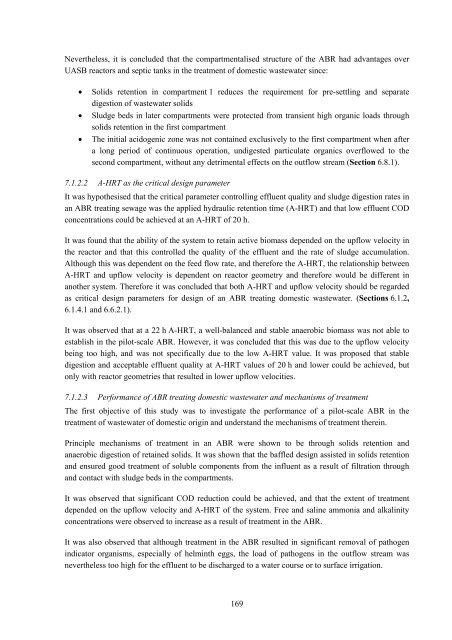analysis of a pilot-scale anaerobic baffled reactor treating domestic ...
analysis of a pilot-scale anaerobic baffled reactor treating domestic ...
analysis of a pilot-scale anaerobic baffled reactor treating domestic ...
You also want an ePaper? Increase the reach of your titles
YUMPU automatically turns print PDFs into web optimized ePapers that Google loves.
Nevertheless, it is concluded that the compartmentalised structure <strong>of</strong> the ABR had advantages over<br />
UASB <strong>reactor</strong>s and septic tanks in the treatment <strong>of</strong> <strong>domestic</strong> wastewater since:<br />
• Solids retention in compartment 1 reduces the requirement for pre-settling and separate<br />
digestion <strong>of</strong> wastewater solids<br />
• Sludge beds in later compartments were protected from transient high organic loads through<br />
solids retention in the first compartment<br />
• The initial acidogenic zone was not contained exclusively to the first compartment when after<br />
a long period <strong>of</strong> continuous operation, undigested particulate organics overflowed to the<br />
second compartment, without any detrimental effects on the outflow stream (Section 6.8.1).<br />
7.1.2.2 A-HRT as the critical design parameter<br />
It was hypothesised that the critical parameter controlling effluent quality and sludge digestion rates in<br />
an ABR <strong>treating</strong> sewage was the applied hydraulic retention time (A-HRT) and that low effluent COD<br />
concentrations could be achieved at an A-HRT <strong>of</strong> 20 h.<br />
It was found that the ability <strong>of</strong> the system to retain active biomass depended on the upflow velocity in<br />
the <strong>reactor</strong> and that this controlled the quality <strong>of</strong> the effluent and the rate <strong>of</strong> sludge accumulation.<br />
Although this was dependent on the feed flow rate, and therefore the A-HRT, the relationship between<br />
A-HRT and upflow velocity is dependent on <strong>reactor</strong> geometry and therefore would be different in<br />
another system. Therefore it was concluded that both A-HRT and upflow velocity should be regarded<br />
as critical design parameters for design <strong>of</strong> an ABR <strong>treating</strong> <strong>domestic</strong> wastewater. (Sections 6.1.2,<br />
6.1.4.1 and 6.6.2.1).<br />
It was observed that at a 22 h A-HRT, a well-balanced and stable <strong>anaerobic</strong> biomass was not able to<br />
establish in the <strong>pilot</strong>-<strong>scale</strong> ABR. However, it was concluded that this was due to the upflow velocity<br />
being too high, and was not specifically due to the low A-HRT value. It was proposed that stable<br />
digestion and acceptable effluent quality at A-HRT values <strong>of</strong> 20 h and lower could be achieved, but<br />
only with <strong>reactor</strong> geometries that resulted in lower upflow velocities.<br />
7.1.2.3 Performance <strong>of</strong> ABR <strong>treating</strong> <strong>domestic</strong> wastewater and mechanisms <strong>of</strong> treatment<br />
The first objective <strong>of</strong> this study was to investigate the performance <strong>of</strong> a <strong>pilot</strong>-<strong>scale</strong> ABR in the<br />
treatment <strong>of</strong> wastewater <strong>of</strong> <strong>domestic</strong> origin and understand the mechanisms <strong>of</strong> treatment therein.<br />
Principle mechanisms <strong>of</strong> treatment in an ABR were shown to be through solids retention and<br />
<strong>anaerobic</strong> digestion <strong>of</strong> retained solids. It was shown that the <strong>baffled</strong> design assisted in solids retention<br />
and ensured good treatment <strong>of</strong> soluble components from the influent as a result <strong>of</strong> filtration through<br />
and contact with sludge beds in the compartments.<br />
It was observed that significant COD reduction could be achieved, and that the extent <strong>of</strong> treatment<br />
depended on the upflow velocity and A-HRT <strong>of</strong> the system. Free and saline ammonia and alkalinity<br />
concentrations were observed to increase as a result <strong>of</strong> treatment in the ABR.<br />
It was also observed that although treatment in the ABR resulted in significant removal <strong>of</strong> pathogen<br />
indicator organisms, especially <strong>of</strong> helminth eggs, the load <strong>of</strong> pathogens in the outflow stream was<br />
nevertheless too high for the effluent to be discharged to a water course or to surface irrigation.<br />
169
















